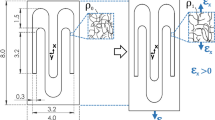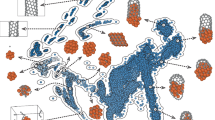Abstract
Artificial neural networks are employed to predict stress–strain curves for all single-walled carbon nanotube configurations with diameters up to 4 nm. Three model architectures are investigated for the molecular dynamics-derived dataset: a multilayer perceptron, a one-dimensional convolutional neural network, and a residual neural network. The performance of the three models is compared, and they are found to closely match an atomistic-physics-based paradigm while being orders of magnitude faster. The effect of the dataset size on the prediction quality is analyzed. It is shown that 30% of the entire carbon nanotube configuration dataset is representative of the problem. Remarkably, all models demonstrate high accuracy, capturing even the smallest variations due to thermal fluctuations, and can provide averaged stress–strain curves without thermal fluctuations. Additionally, a sensitivity analysis was performed to investigate how the various input feature combinations affect the quality of elimination or prediction of thermal fluctuations. The results are determined by different combinations of input features, with current diameter in combination with temperature identified as the most important parameters affecting the inclusion or exclusion of thermal fluctuations.










Similar content being viewed by others
References
Rafii-Tabar H (2008) Computational physics of carbon nanotubes, 1st edn. Cambridge University Press, Cambridge. https://doi.org/10.1017/CBO9780511541278
Liu B, Sun X, Bhattacharya K, Ortiz M (2021) Hierarchical multiscale quantification of material uncertainty. J Mech Phys Solids 153:104492. https://doi.org/10.1016/j.jmps.2021.104492
Uskokovic V (2009) Challenges for the modern science in its descend towards nano scale. Curr Nanosci 5(3):372–389. https://doi.org/10.2174/157341309788921381
Rao R, Pint CL, Islam AE, Weatherup RS, Hofmann S, Meshot ER, Wu F, Zhou C, Dee N, Amama PB et al (2018) Carbon nanotubes and related nanomaterials: critical advances and challenges for synthesis toward mainstream commercial applications. ACS Nano 12(12):11756–11784. https://doi.org/10.1021/acsnano.8b06511
Liew KM, He XQ, Wong CH (2004) On the study of elastic and plastic properties of multi-walled carbon nanotubes under axial tension using molecular dynamics simulation. Acta Mater 52(9):2521–2527. https://doi.org/10.1016/j.actamat.2004.01.043
Mylvaganam K, Zhang LC (2004) Important issues in a molecular dynamics simulation for characterising the mechanical properties of carbon nanotubes. Carbon 42(10):2025–2032. https://doi.org/10.1016/j.carbon.2004.04.004
Ma J, Wang J-N, Tsai C-J, Nussinov R, Ma B (2010) Diameters of single-walled carbon nanotubes (swcnts) and related nanochemistry and nanobiology. Front Mater Sci China 4(1):17–28. https://doi.org/10.1007/s11706-010-0001-8
Kok ZKJ, Wong CH (2016) Molecular dynamics simulation studies of mechanical properties of different carbon nanotube systems. Mol Simul 42(15):1274–1280. https://doi.org/10.1080/08927022.2016.1185790
Dereli G, Süngü B (2007) Temperature dependence of the tensile properties of single-walled carbon nanotubes: \(\rm O(n)\) tight-binding molecular-dynamics simulations. Phys Rev B 75:184104. https://doi.org/10.1103/PhysRevB.75.184104
Gupta S, Dharamvir K, Jindal VK (2005) Elastic moduli of single-walled carbon nanotubes and their ropes. Phys Rev B 72:165428. https://doi.org/10.1103/PhysRevB.72.165428
Zhou LG, Shi SQ (2002) Molecular dynamic simulations on tensile mechanical properties of single-walled carbon nanotubes with and without hydrogen storage. Comput Mater Sci 23(1–4):166–174. https://doi.org/10.1016/S0927-0256(01)00233-6
Lu JP (1997) Elastic properties of carbon nanotubes and nanoropes. Phys Rev Lett 79(7):1297–1300. https://doi.org/10.1103/PhysRevLett.79.1297
Yazdani H, Hatami K, Eftekhari M (2017) Mechanical properties of single-walled carbon nanotubes: a comprehensive molecular dynamics study. Mater Res Express. https://doi.org/10.1088/2053-1591/aa7003
Čanađija M (2021) Deep learning framework for carbon nanotubes: mechanical properties and modeling strategies. Carbon 184:891–901. https://doi.org/10.1016/j.carbon.2021.08.091
Kirchdoerfer T, Ortiz M (2016) Data-driven computational mechanics. Comput Methods Appl Mech Eng 304:81–101. https://doi.org/10.1016/j.cma.2016.02.001
Karapiperis K, Stainier L, Ortiz M, Andrade J (2021) Data-driven multiscale modeling in mechanics. J Mech Phys Solids 147:104239. https://doi.org/10.1016/j.jmps.2020.104239
Förster GD, Castan A, Loiseau A, Nelayah J, Alloyeau D, Fossard F, Bichara C, Amara H (2020) A deep learning approach for determining the chiral indices of carbon nanotubes from high-resolution transmission electron microscopy images. Carbon 169:465–474. https://doi.org/10.1016/j.carbon.2020.06.086
Rao R, Carpena-Núñez J, Nikolaev P, Susner MA, Reyes KG, Maruyama B (2021) Advanced machine learning decision policies for diameter control of carbon nanotubes. npj Comput Mater 7(1):1–9. https://doi.org/10.1038/s41524-021-00629-y
Zhao Q, Winetrout JJ, Xu Y, Wang Y, Heinz H (2021) Prediction of carbon nanostructure mechanical properties and role of defects using machine learning. arXiv: org/abs/2110.00517
Yadav U, Pathrudkar S, Ghosh S (2021) Interpretable machine learning model for the deformation of multiwalled carbon nanotubes. Phys Rev B 103(3):035407. https://doi.org/10.1103/PhysRevB.103.035407
Vijayaraghavan V, Garg A, Wong C, Tai K (2014) Estimation of mechanical properties of nanomaterials using artificial intelligence methods. Appl Phys A 116(3):1099–1107. https://doi.org/10.1007/s00339-013-8192-3
Vivanco-Benavides LE, Martínez-González CL, Mercado-Zúñiga C, Torres-Torres C (2022) Machine learning and materials informatics approaches in the analysis of physical properties of carbon nanotubes: A review. Comput Mater Sci 201:110939. https://doi.org/10.1016/j.commatsci.2021.110939
Le Cun Y, Boser B, Denker JS, Henderson D, Howard RE, Hubbard W, Jackel LD (1989) Handwritten digit recognition with a back-propagation network. In: Proceedings of the 2nd international conference on neural information processing systems. NIPS’89. MIT Press, Cambridge, MA, USA, pp 396– 404 ( 1989)
He K, Zhang X, Ren S, Sun J (2016) Deep residual learning for image recognition. In: 2016 IEEE conference on computer vision and pattern recognition (CVPR), pp 770– 778 . https://doi.org/10.1109/CVPR.2016.90
Chen D, Hu F, Nian G, Yang T (2020) Deep residual learning for nonlinear regression. Entropy 22(2):193. https://doi.org/10.3390/e22020193
Malhotra BD, Srivastava S, Augustine S (2015) Biosensors for food toxin detection: carbon nanotubes and graphene. MRS Online Proceedings Library (OPL), vol 1725. https://doi.org/10.1557/opl.2015.165
Kajendirarajah U, Avilés MO, Lagugné-Labarthet F (2020) Deciphering tip-enhanced raman imaging of carbon nanotubes with deep learning neural networks. Phys Chem Chem Phys 22(32):17857–17866. https://doi.org/10.1039/D0CP02950E
Alzubaidi L, Zhang J, Humaidi AJ, Al-Dujaili A, Duan Y, Al-Shamma O, Santamaría J, Fadhel MA, Al-Amidie M, Farhan L (2021) Review of deep learning: concepts, CNN architectures, challenges, applications, future directions. J Big Data 8(1):1–74. https://doi.org/10.1186/s40537-021-00444-8
Plimpton S (1995) Fast parallel algorithms for short-range molecular dynamics. J Comput Phys 117(1):1–19. https://doi.org/10.1006/jcph.1995.1039
Shenderova O, Brenner D, Omeltchenko A, Su X, Yang L (2000) Atomistic modeling of the fracture of polycrystalline diamond. Phys Rev B 61(6):3877. https://doi.org/10.1103/PhysRevB.61.3877
Košmerl V, Štajduhar I, Čanađija M. SWCNT dataset and CNN models. https://doi.org/10.17632/t835gsrt66.1
Pedregosa F, Varoquaux G, Gramfort A, Michel V, Thirion B, Grisel O, Blondel M, Prettenhofer P, Weiss R, Dubourg V et al (2011) Scikit-learn: machine learning in Python. J Mach Learn Res 12:2825–2830
Goodfellow I, Bengio Y, Courville A (2016) Deep learning, 1st edn. MIT Press, Cambridge
Chollet F et al (2015) Keras. https://keras.io
Agarap AF (2018) Deep learning using rectified linear units (ReLu). arXiv:1803.08375
Kingma DP, Ba J (2014) Adam: a method for stochastic optimization. arXiv:1412.6980. https://doi.org/10.48550/arXiv.1412.6980
Kiranyaz S, Avci O, Abdeljaber O, Ince T, Gabbouj M, Inman DJ (2021) 1D convolutional neural networks and applications: a survey. Mech Syst Signal Process. https://doi.org/10.1016/j.ymssp.2020.107398
Adhikari A, Ram A, Tang R, Lin J (2019) Rethinking complex neural network architectures for document classification. In: Proceedings of the 2019 conference of the North American chapter of the association for computational linguistics: human language technologies, vol 1 (Long and short papers), pp 4046–4051. https://aclanthology.org/N19-1408
Phaniraj MP, Lahiri AK (2003) The applicability of neural network model to predict flow stress for carbon steels. J Mater Process Technol 141(2):219–227. https://doi.org/10.1016/S0924-0136(02)01123-8
Acknowledgements
This work has been supported in full by the Croatian Science Foundation under the project IP-2019-04-4703 and partially supported by the University of Rijeka under the project number uniri-tehnic-18-37. These supports are gratefully acknowledged.
Research data
The input dataset file with data about all SWCNT configurations and CNN models are available at Košmerl, Valentina; Štajduhar, Ivan; Čanađija, Marko (2022), SWCNT Dataset and CNN Models, Mendeley Data, V1, doi: 10.17632/t835gsrt66.1.
Author information
Authors and Affiliations
Corresponding author
Ethics declarations
Conflict of interest
The authors have no competing interests to declare that are relevant to the content of this article.
Code availability
All experiments were carried out on a publicly available data set.
Additional information
Publisher's Note
Springer Nature remains neutral with regard to jurisdictional claims in published maps and institutional affiliations.
Appendix: Supplementary figures
Appendix: Supplementary figures
The present study has yielded a variety of results which we hope will be of interest to the reader. For clarity, only the most relevant illustrations are used in the main body of the article; the others are presented in the Appendix. Comments are provided in the main text.
See Figures 11, 12, 13 and 14.
Rights and permissions
About this article
Cite this article
Košmerl, V., Štajduhar, I. & Čanađija, M. Predicting stress–strain behavior of carbon nanotubes using neural networks. Neural Comput & Applic 34, 17821–17836 (2022). https://doi.org/10.1007/s00521-022-07430-y
Received:
Accepted:
Published:
Issue Date:
DOI: https://doi.org/10.1007/s00521-022-07430-y








